6 X Green Neon Tetras – Paracheirodon Simulans CB – South American Tetras (Copy), Stunning Tropical Fish That Thrive in Planted Tanks, Perfect Companions for Peaceful Species
£25.49 Original price was: £25.49.£21.29Current price is: £21.29.
Welcome these beautiful 6 X Green Neon Tetras – Paracheirodon Simulans CB – to your aquarium. Their stunning neon green coloration and graceful movements make them perfect for community tanks. Ideal for both beginners and experienced aquarists seeking peaceful companions.
1994 in stock
Species Introduction
The Green Neon Tetra, scientifically known as Paracheirodon simulans, is a captivating species belonging to the Characidae family. Originating from the lush waters of the Amazon Basin in South America, these small, vibrant fish are a popular choice among aquarists due to their striking coloration and peaceful nature. Typically reaching a maximum length of about 4 cm, they are ideal for community tanks and can coexist harmoniously with a variety of other freshwater fish species. Their natural habitat consists of slow-moving streams and rivers, where they thrive among dense vegetation and submerged structures. This environment not only provides them with safety from predators but also plays a crucial role in their social behavior and overall well-being.
Care Requirements Dashboard
Essential Care Guide for Your 6 X Green Neon Tetras – Paracheirodon Simulans CB – South American Tetras
| Optimal Living Conditions | |
|---|---|
| Water Temperature | 24-27°C (75-81°F) |
| pH Level | 6.5-7.5 |
| Water Hardness | 4-12 dKH |
| Minimum Tank Size | 80L (20 gal) |
| Salinity | Freshwater |
| Care Level | Beginner Friendly |
✓ Care Level: Easy
To provide a suitable home for Green Neon Tetras, it is essential to maintain a well-balanced aquarium environment. The recommended tank size is at least 10 gallons, allowing for ample swimming space and suitable schooling conditions. The water parameters should be kept within specific ranges: a pH of 6.0 to 7.0, a temperature range of 22°C to 28°C (72°F to 82°F), and a hardness level of 2 to 10 dGH. Regular water changes and the use of a reliable filtration system are critical to ensure optimal water quality. Additionally, providing live plants and hiding spots will help replicate their natural habitat, making them feel secure and encouraging natural behaviors.
Natural Behavior & Temperament
Green Neon Tetras are known for their peaceful demeanor and social nature, making them excellent additions to community tanks. They are schooling fish, which means they thrive in groups of at least six individuals. In a well-maintained aquarium, you will observe their delightful swimming patterns as they dart around the tank in synchronized movements. Their natural behavior includes foraging for food among the plants and swimming in open water, showcasing their vibrant colors. It is important to note that they can become stressed if kept alone or in small numbers, so ensuring a proper school size is essential for their well-being.
Tank Setup Guide
Setting up a tank for Green Neon Tetras requires careful consideration of their natural habitat. Begin with a spacious aquarium, ideally 10 gallons or larger, to accommodate a school of these lively fish. The substrate should be soft and dark, such as fine gravel or sand, to mimic the riverbeds of their native environment. Incorporate plenty of live plants, such as Java fern and Anubias, which not only provide hiding spots but also contribute to the overall aesthetics of the tank. Additionally, include driftwood and rocks to create natural structures and territories. Ensure that the tank is equipped with a gentle filtration system to maintain water quality without creating strong currents, as these fish prefer calm waters.
Water Quality Management
✓ Water Parameters: pH 6.0 – 7.0, Temperature 22°C – 28°C
Maintaining excellent water quality is crucial for the health of your Green Neon Tetras. Regular testing of water parameters is essential to ensure they remain within the ideal ranges. The pH level should be between 6.0 and 7.0, while the water temperature should be maintained between 22°C and 28°C (72°F to 82°F). The hardness of the water should be kept between 2 to 10 dGH. Frequent water changes, approximately 25% weekly, will help remove toxins and replenish essential minerals. Additionally, using a high-quality water conditioner can aid in detoxifying harmful chemicals, ensuring a safe environment for your fish friends.
Feeding & Nutrition
Feeding Green Neon Tetras a balanced diet is vital for their health and vibrancy. They are omnivorous and thrive on a varied diet that includes high-quality flake food, micro-pellets, and live or frozen foods such as brine shrimp and daphnia. A feeding schedule of two to three small meals per day is recommended, ensuring that they consume the food within a few minutes to prevent water quality issues. It is also beneficial to supplement their diet with vegetable-based foods or spirulina to enhance their coloration and overall health. Observing their feeding behavior can also provide insights into their well-being; healthy fish will eagerly swim to the surface during feeding times.
Compatibility Guide
✓ Community Tank Friendly
Green Neon Tetras are known for their peaceful nature, making them ideal for community tanks. They can coexist with a variety of other small, non-aggressive fish species. Suitable tank mates include other tetras, rasboras, guppies, and small catfish. It is essential to avoid larger or aggressive fish that may view them as prey. When selecting tank mates, consider the swimming levels of different species to ensure a harmonious environment. A well-balanced community tank will not only enhance the beauty of your aquarium but also promote the natural behaviors of your Green Neon Tetras.
Health & Wellness
Monitoring the health of your Green Neon Tetras is essential for their longevity and vitality. Common health issues include ich, fin rot, and other parasitic infections. Regular observation of their behavior and physical appearance can help identify potential problems early. Signs of stress or illness may include lethargy, loss of appetite, or abnormal swimming patterns. Maintaining optimal water quality and a balanced diet is crucial in preventing health issues. In case of any health concerns, it is advisable to consult with an aquatic veterinarian or a knowledgeable aquarist for appropriate treatment options.
Breeding Information
Breeding Green Neon Tetras can be a rewarding experience for aquarists. To encourage spawning, it is recommended to set up a separate breeding tank with soft, acidic water and plenty of fine-leaved plants for the eggs to adhere to. A temperature of around 26°C (79°F) is ideal for breeding. Once the female lays her eggs, which can number in the hundreds, it is crucial to remove the adults from the tank to prevent them from eating the eggs. The eggs typically hatch within 24 to 36 hours, and the fry can be fed infusoria or finely crushed flakes until they are large enough to consume regular food. Careful monitoring and maintenance of water quality during this period are vital for the successful growth of the fry.
Acclimation Process
✓ Gradual Acclimation Recommended
Introducing Green Neon Tetras to a new aquarium requires a careful acclimation process to minimize stress. Begin by floating the sealed bag containing the fish in the aquarium for about 15-20 minutes to equalize the temperature. After this, gradually mix small amounts of aquarium water into the bag over the course of an hour. This will help the fish adjust to the new water parameters. Once acclimated, gently release the fish into the tank using a net to avoid introducing any transport water. This method ensures a smooth transition and promotes the health and well-being of your new aquatic companions.
Long-term Care
Green Neon Tetras have a lifespan of approximately 5 to 8 years when provided with optimal care. As they grow, it is essential to monitor their development and adjust their living conditions accordingly. Regular maintenance, including water changes and tank cleaning, will help maintain a healthy environment. Additionally, keeping an eye on their social dynamics within the tank will ensure that they remain happy and stress-free. Providing a varied diet, proper tank mates, and a well-maintained habitat will contribute to their longevity and vibrant health.
Natural Habitat Recreation
Recreating the natural habitat of Green Neon Tetras in your aquarium can enhance their well-being and display their natural behaviors. Incorporate a variety of live plants, such as floating and rooted species, to provide cover and foraging opportunities. The use of driftwood and rocks can create hiding spots and territories, mimicking the complexity of their native environment. Additionally, maintaining a dark substrate will help highlight their vibrant colors, making your aquarium a stunning visual display. By focusing on biotope setup, you not only create a beautiful aquarium but also promote the health and happiness of your fish friends.
Seasonal Care Adjustments
As seasons change, so do the conditions in your aquarium. During warmer months, it is essential to monitor the water temperature closely, as elevated temperatures can stress your Green Neon Tetras. Consider using a fan or chiller to maintain a stable environment. In contrast, during colder months, ensure that your heater is functioning correctly to keep the water within the ideal temperature range. Additionally, adjusting the lighting duration can mimic natural seasonal changes, promoting healthy growth patterns in both fish and plants. Regularly reviewing and adapting your care routine will ensure that your aquatic companions thrive year-round.
Expert Tips
✓ Advanced Techniques for Care
For those looking to deepen their knowledge of Green Neon Tetra care, consider implementing advanced techniques such as establishing a breeding program or creating a dedicated biotope aquarium. Researching the specific needs of your fish friends will enhance your overall experience and success. Additionally, participating in local aquarist clubs or online forums can provide valuable insights and tips from experienced keepers. Regularly updating your knowledge on best practices will not only improve your skills but also contribute to the well-being of your aquatic companions.
Troubleshooting
Despite your best efforts, challenges may arise in maintaining a healthy aquarium for your Green Neon Tetras. Common issues include algae overgrowth, water quality fluctuations, and compatibility problems with tank mates. To address these challenges, regularly test your water parameters and adjust your maintenance routine as needed. Implementing a consistent cleaning schedule and avoiding overfeeding can significantly reduce algae growth. If compatibility issues arise, consider re-evaluating your tank mates and removing any aggressive species. Staying proactive and informed will help you navigate any obstacles in your aquarium journey.
Scientific Background
The Green Neon Tetra, Paracheirodon simulans, is part of a larger group of tetras that are widely studied for their ecological significance and popularity in the aquarium trade. Their taxonomy places them within the Characidae family, known for their diverse range of species. Research into their behavior, breeding habits, and environmental needs continues to provide valuable insights into their care and conservation. Awareness of their natural habitats and the challenges they face in the wild is essential for responsible fishkeeping and promoting sustainable practices within the aquarium hobby.
Advanced Care Techniques
For experienced aquarists, exploring advanced care techniques can lead to a deeper understanding of Green Neon Tetras and their needs. Consider experimenting with different breeding methods, such as using a separate breeding tank or adjusting environmental conditions to encourage spawning. Additionally, integrating advanced filtration systems or automated monitoring devices can enhance water quality management and reduce manual labor. Engaging in ongoing education through workshops, literature, and expert consultations will further enrich your experience and success in keeping these beautiful aquatic companions.
Frequently Asked Questions
Q: What tank size is required for Green Neon Tetras?
Green Neon Tetras thrive in a minimum tank size of 10 gallons (approximately 38 litres). This allows them ample swimming space and helps maintain stable water parameters. A larger tank is preferable, as it enables a more balanced ecosystem, reducing stress among the fish. It is important to provide a well-planted environment with plenty of hiding spots, as these fish enjoy feeling secure. Remember, the more fish you introduce, the larger the tank should be to prevent overcrowding and ensure a healthy environment.
✓ Expert Tip
Consider a tank with a lid, as Green Neon Tetras can be jumpy and may leap out if startled.
Q: What water parameters do Green Neon Tetras require?
Green Neon Tetras prefer slightly acidic to neutral water, with a pH range of 6.0 to 7.0. The water temperature should be maintained between 22°C to 26°C (72°F to 79°F). Regular water changes of about 10-15% weekly will help maintain optimal water quality. Ammonia and nitrite levels should be kept at 0 ppm, whilst nitrate levels should not exceed 20 ppm. Always test your water parameters regularly to ensure a stable and healthy environment for your fish friends.
✓ Expert Tip
Utilise a high-quality water conditioner to remove harmful chemicals from tap water before adding it to the tank.
Q: How often should I feed Green Neon Tetras?
Green Neon Tetras should be fed small amounts of high-quality flake or pellet food designed for tropical fish, twice daily. It is crucial to provide only as much food as they can consume within a few minutes to prevent overfeeding, which can lead to water quality issues. Supplement their diet with live or frozen foods like brine shrimp or daphnia once or twice a week, as this enhances their colouration and overall health. Remember, variety is key to a balanced diet.
✓ Expert Tip
Observe their feeding behaviour; if they appear uninterested, reduce the quantity and try a different food type.
Q: What are the best tank mates for Green Neon Tetras?
Green Neon Tetras are peaceful and sociable fish, making them ideal companions for similarly sized and temperament species. Suitable tank mates include other tetras, rasboras, guppies, and small catfish like Corydoras. Avoid larger or aggressive fish, as they can stress or prey on your tetras. It is advisable to keep them in groups of at least six to promote their natural schooling behaviour, which also reduces stress levels. A well-balanced community tank enhances their vibrant colours and lively behaviour.
✓ Expert Tip
Introduce new fish gradually to avoid disturbing the established social dynamics in the tank.
Q: How do I properly acclimatise Green Neon Tetras to my aquarium?
Acclimatising your Green Neon Tetras is essential to minimise stress and ensure a smooth transition to their new home. Begin by floating the sealed bag in your aquarium for about 15 minutes to equalise the temperature. After this, gradually introduce small amounts of your aquarium water into the bag every 5-10 minutes for approximately an hour. This process allows the fish to adjust to the water parameters of their new environment. Finally, gently net the fish and transfer them to the tank, discarding the bag water to avoid introducing contaminants.
✓ Expert Tip
Perform this process during low-light hours to reduce stress and allow them to acclimatise effectively.
Q: What are the signs of healthy Green Neon Tetras?
Healthy Green Neon Tetras exhibit vibrant colours, active swimming behaviour, and a keen interest in their surroundings. Their fins should be fully extended, and they should swim in a coordinated manner with their tank mates. Look for clear eyes and a rounded belly, indicating they are well-fed. Any signs of lethargy, faded colours, or unusual swimming patterns could indicate stress or health issues. Regular observation is key to ensuring their wellbeing and promptly addressing any potential concerns.
✓ Expert Tip
Maintain a consistent routine for feeding and tank maintenance to promote a stable environment for your fish friends.
Q: How do I successfully breed Green Neon Tetras?
Breeding Green Neon Tetras requires specific conditions. Set up a separate breeding tank with soft, slightly acidic water and plenty of plants for spawning. Introduce a male and female pair, ensuring they are well-fed prior to breeding. The female will lay eggs among the plants, which will typically hatch in 24-36 hours. Remove the parents after spawning to prevent them from eating the eggs. The fry will require infusoria or finely crushed food until they are large enough for regular flakes or pellets.
✓ Expert Tip
Maintain stable water conditions and provide gentle filtration to protect the delicate fry.
Q: What temperature should I maintain for Green Neon Tetras?
The ideal temperature range for Green Neon Tetras is between 22°C to 26°C (72°F to 79°F). Maintaining a stable temperature is crucial, as fluctuations can stress the fish and lead to health issues. It is advisable to use a reliable aquarium heater and thermometer to monitor the temperature consistently. Regularly check for any changes in water temperature, especially during seasonal shifts, to ensure your fish friends remain comfortable and healthy.
✓ Expert Tip
Consider using a heater with a thermostat for precise temperature control and stability.
Q: How long do Green Neon Tetras typically live in captivity?
In captivity, Green Neon Tetras typically live for about 5 to 8 years, provided they are given optimal care. Factors such as water quality, diet, and tank conditions play a significant role in their lifespan. Regular maintenance of the aquarium, including water changes and monitoring of tank parameters, contributes to their longevity. By creating a stress-free environment with appropriate tank mates and hiding spots, you can help ensure a longer, healthier life for your fish friends.
✓ Expert Tip
Keep a close eye on their behaviour and health to catch any issues early and maintain their wellbeing.
Q: What type of substrate is most suitable for Green Neon Tetras?
Green Neon Tetras prefer a fine substrate, such as sand or small gravel, which mimics their natural habitat. A softer substrate protects their delicate bodies and allows them to forage naturally. Additionally, incorporating live plants and driftwood into the tank will enhance their environment and provide hiding spots, crucial for their sense of security. Avoid sharp or coarse substrates that could injure your fish friends, as their wellbeing is paramount.
✓ Expert Tip
Consider adding a layer of nutrient-rich substrate beneath the top layer to promote plant growth.
Q: What behavioural patterns should I expect from Green Neon Tetras?
Green Neon Tetras are known for their lively and social behaviour. They thrive in schools, often swimming together in coordinated groups, which is a natural instinct that provides them with a sense of security. Expect them to be active swimmers, darting around the tank and exploring their environment. They may also display occasional playful behaviour, such as chasing one another. It is essential to provide ample space and hiding spots to facilitate their natural behaviours and reduce stress levels.
✓ Expert Tip
Observe their social interactions; any signs of aggression may indicate overcrowding or unsuitable tank mates.
Q: How can I prevent common diseases in Green Neon Tetras?
Preventing diseases in Green Neon Tetras begins with maintaining high water quality through regular testing and water changes. Avoid overfeeding, as uneaten food can pollute the tank. Quarantine new fish before introducing them to your aquarium to prevent the spread of diseases. Additionally, monitor the tank for signs of stress or illness, such as unusual swimming patterns or loss of colour. A balanced diet rich in vitamins and minerals can also bolster their immune system, keeping them healthy.
✓ Expert Tip
Consider adding aquarium salt in moderation to boost their resilience against common ailments.
Q: What lighting conditions do Green Neon Tetras prefer?
Green Neon Tetras thrive in moderate lighting that mimics their natural habitat, which is often shaded by dense vegetation. It is advisable to utilise a light that can be dimmed or adjusted to create a more natural environment. Bright lights can stress them and encourage algae growth, so consider using floating plants or decorations to diffuse the light. A consistent light cycle of 10-12 hours a day will help maintain their health and promote the growth of any live plants in the tank.
✓ Expert Tip
Utilise a timer to regulate lighting and maintain a consistent day-night cycle for your fish friends.
Q: How do I recognise stress in Green Neon Tetras?
Recognising stress in Green Neon Tetras involves observing their behaviour and physical appearance. Signs of stress may include lethargy, hiding more than usual, or erratic swimming patterns. They may also display faded colours or clamped fins, indicating discomfort. Additionally, if they are not eating or interacting with other fish, it may suggest that they are stressed. It is essential to identify the cause of stress, such as poor water quality, unsuitable tank mates, or sudden changes in their environment, and address it promptly.
✓ Expert Tip
Create a peaceful environment with plenty of hiding spots to help reduce stress levels among your fish friends.
Q: What natural habitat conditions should I replicate for Green Neon Tetras?
To replicate the natural habitat of Green Neon Tetras, aim for a densely planted aquarium with plenty of hiding spots. They are native to the blackwater rivers of South America, characterised by soft, slightly acidic water and subdued lighting. Incorporating driftwood and leaf litter can create a more authentic environment. Maintain a gentle water flow and ensure that the tank is well-filtered to mimic their natural conditions. Regular water changes will help maintain the quality and stability that these beautiful creatures thrive in.
✓ Expert Tip
Consider using natural materials that do not leach harmful substances into the water for a safe and healthy environment.

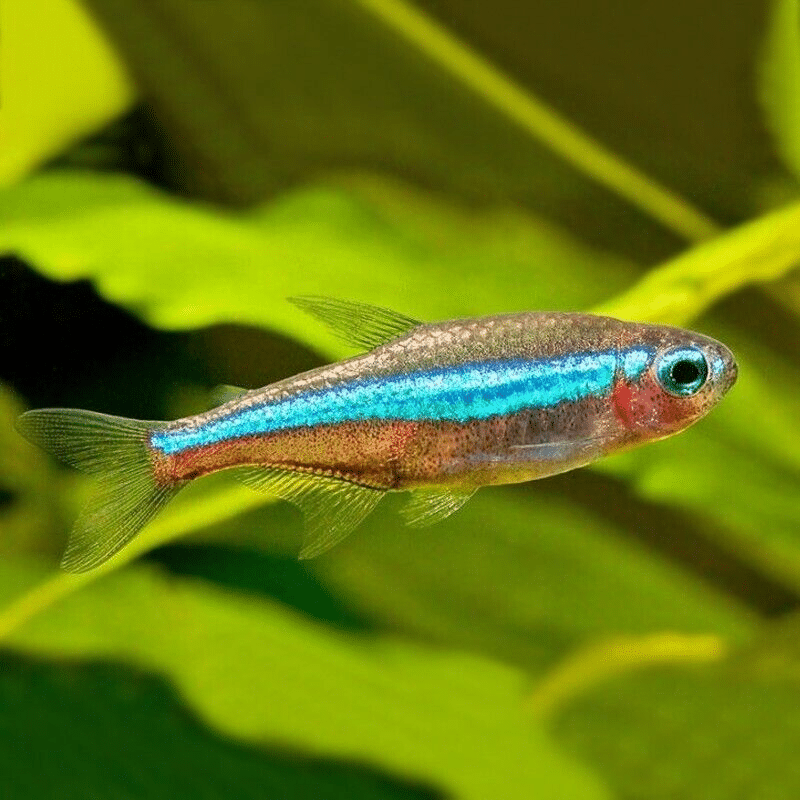
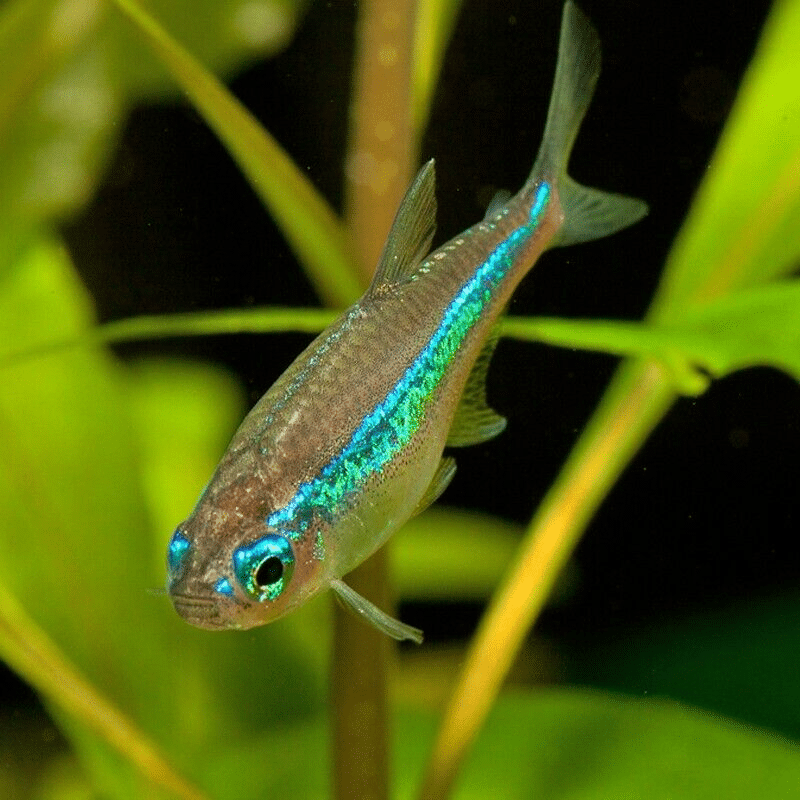
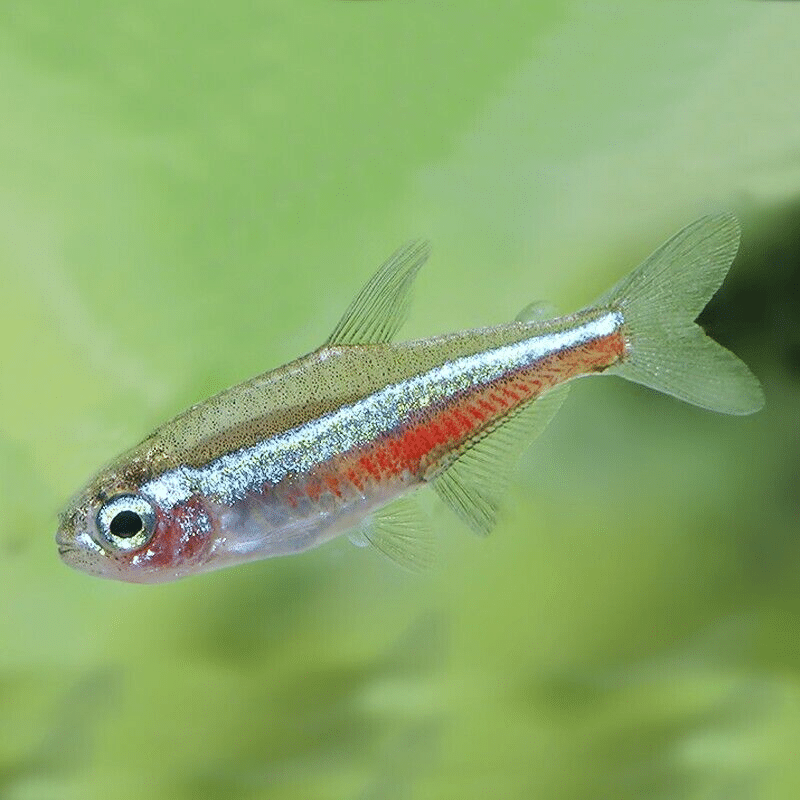
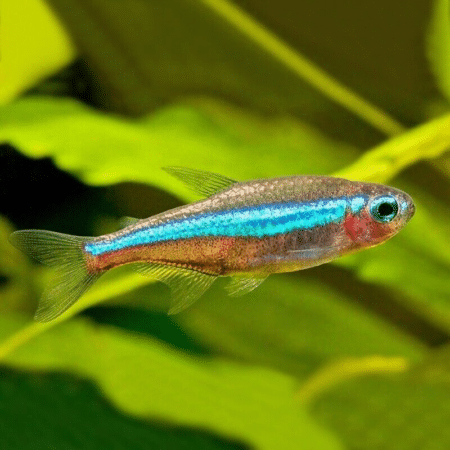


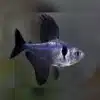











Emily Thompson (verified owner) –
I recently purchased the 6 Green Neon Tetras, and I couldn’t be happier! These little fish have transformed my aquarium into a lively underwater paradise. After just one week, they settled in beautifully and started showing off their stunning colors. The iridescent blue and green hues are absolutely mesmerizing and add a nice pop of color to my tank.
I appreciate that these are captive-bred (CB) neon tetras, which gives me peace of mind regarding their health and wellbeing. They are peaceful and get along well with my other freshwater fish, making them perfect for a community tank.
In comparison to other tetra varieties I’ve tried, these seem more resilient and active. The shipping was prompt, and the fish arrived healthy and lively, which is so important when it comes to aquarium fish. My only minor concern was that they took a little longer to adapt to the water conditions than expected, but after a few days, they thrived!
I highly recommend the Green Neon Tetras for anyone looking to enhance their aquarium with beautiful and dynamic freshwater fish. They’re perfect for both beginner and experienced aquarists. I will definitely buy again!